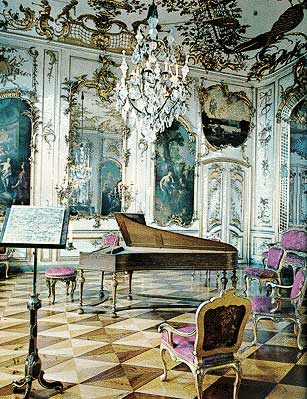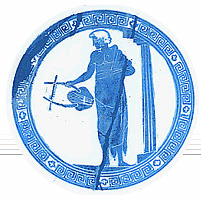THE BAROQUE
| BAROQUE
(1600-1750) |
 |
|
 |
A
musical period from 1600, (with the invention of opera), to
1750, (the death of Bach). Baroque was a derogatory term used
in the 17th Century to describe any thing over-decorated,
excessive, flamboyant, or grotesque. The art work was dazzling
and elaborate, the architecture was embellished and the furniture
was full of filigree. The music was extravagantl, ornamented,
full of polyphony, and rhythm. The ever decreasing power of
the Church gave rise to the absolute monarchs, kings and aristocrats
who sought to celebrate themselves in opulent, extravagant
art, architecture and music. This was at the same time the
Age of Science. The scientific climate of the time led to
a new emphasis on logic and control. Newton developed the
theory of gravity, Galileo developed the telescope, functional
harmony came into being, the tempered tuning system became
standard, and major and minor scales replaced the old church
modes in importance.
 |
 |
Baroque
music room. |
This
new systematic approach manifested itself musically in carefully
controlled instrumental forms such as fugue, passacaglia,
chaconne, concerto, concerto grosso, dance suite, variations
and ground bass. It was a time when composers wanted their
music to deal with passionate emotions. It was the job of
the composer to find the musical expression that would give
and audience the feeling of "affection" i.e.. sorrow,
heroism, devotion, etc. The Baroque period was the beginning
for what almost all musical styles are today. Composers include:
J. S. Bach, Antonio Vivaldi and for voices and Orchestra George
F. Handel.
| CONCERTO
GROSSO |
 |
|
 |
The
notion of a concerto is based on the interplay between a soloist
or soloists. Concerto means to contend or strive as in a competition.
The contest in a concerto is between the soloist and the orchestra.
In a concerto there is one soloist playing with or against
an orchestra. In a concerto grosso there is a group of soloists
playing with or against an orchestra. The main theme of a
concerto grosso is called a "ritornello." A ritornello
form movement is based on a periodic return of a central ritornello
theme.
| GROUND
BASS |
 |
|
 |
A motive, phrase, or theme in the bass repeated again and
again as the basis for a composition. A basso continuo is
when a bass instrument that very often plays this bass line
which is reinforced with "continuous" chords or
connecting harmonies played by a harpsichord. Most Ground
Bass forms in the Baroque period had florid polyphony above
the steady Ground. Certainly that is the case in both "Canon
in D" by Johann Pachebel, as well as the "Passacaglia"
in C minor by Johann Sebastian Bach. The example below is
from Pachelbel's Canon which is more of a ground bass with
it's steady bass line than a canon.
| DANCE
SUITE |
 |
|
 |
 |
 |
Baroque
dancers. |
A
collection of dance inspired movements. Each movement is named
according to the type of dance and each movement intends to
capture the feeling and spirit of each of the court dances.
Suite means to follow as one movement follows another in a
dance suite. Similar to use of the word a “suite of
rooms” each connected to each other. The common movements
and their most frequent order are:
 Prelude – an introduction to the collection
of dances usually freer and less steady in its rhythmic design.
It is the only non-dance movement of the set. The prelude
prepares the listener for what is going to follow and is often
in the form of a free improvisation.
Prelude – an introduction to the collection
of dances usually freer and less steady in its rhythmic design.
It is the only non-dance movement of the set. The prelude
prepares the listener for what is going to follow and is often
in the form of a free improvisation.
 Allemande – a graceful moderate tempo, duple
meter court dance. In Italy and parts of France the allemande
uses many rapid notes suggesting flowing movements in which
dance partners always keep both hands joined. Other French
type allemandes contain short dotted figures which create
a music jerk or stutter suggesting regal ness or nobility.
Allemande – a graceful moderate tempo, duple
meter court dance. In Italy and parts of France the allemande
uses many rapid notes suggesting flowing movements in which
dance partners always keep both hands joined. Other French
type allemandes contain short dotted figures which create
a music jerk or stutter suggesting regal ness or nobility.
 Courante – French for “running”
the courante suggests dancers running or jumping while they
dance. The courante is a triple meter dance and the tempo
is fast. When dancers weren’t running in the courante
they were gliding along the dance floor while making gallant
gestures.
Courante – French for “running”
the courante suggests dancers running or jumping while they
dance. The courante is a triple meter dance and the tempo
is fast. When dancers weren’t running in the courante
they were gliding along the dance floor while making gallant
gestures.
 Sarabande – a slow, elegant, triple meter dance.
Usually the most expressive musical movement of the suite.
The Sarabande had sensual movements and has a physical and
consequently a musical emphasis on the second count of the
triple meter.
Sarabande – a slow, elegant, triple meter dance.
Usually the most expressive musical movement of the suite.
The Sarabande had sensual movements and has a physical and
consequently a musical emphasis on the second count of the
triple meter.
 Bourree, Gavotte or Minuet:
Bourree, Gavotte or Minuet:
Bourree
– a lively dance in duple meter. The bourree
begins with an upbeat and is usually strong and rhythmic because
the early bourree’s had dancers dance in wooden shoes
which added additional clatter to the music.
Gavotte
– named after peasants from southern France (gavots)
the gavotte is an energetic dance with lots of leaping. Because
of the sentimental nature of the courtly dance, the music
for the gavotte is often tuneful and the most musically accessible
of all the movements.
Minuet
– the most beloved dance of Louis the XIV. The minuet
is a graceful couples dance in triple meter and may be the
predecessor to the modern day waltz. In the dance of the minuet
the man pays homage to his partner by deeply bowing. Then
the male dancer guides the female through intricate gliding
and bending motions. Hand in hand both dancers perform dainty
retreats and approaches. The word ”minuet” means
small and is taken from the minute motions of the dance.
 Gigue – The fastest movement of the dance suite
and the most vigorous. Most gigues have a galloping type of
rhythm and the meter is usually in compound (a combination
of duple and triple). The compound meter is most noticeable
in the frequent use of running triplets. The gigue appears
as the last movement of the dance and it is typical to hear
imitation in the voices which is unusual for a dance movement.
The driving rhythm of the gigue is an exciting way to end
the series of dance movements.
Gigue – The fastest movement of the dance suite
and the most vigorous. Most gigues have a galloping type of
rhythm and the meter is usually in compound (a combination
of duple and triple). The compound meter is most noticeable
in the frequent use of running triplets. The gigue appears
as the last movement of the dance and it is typical to hear
imitation in the voices which is unusual for a dance movement.
The driving rhythm of the gigue is an exciting way to end
the series of dance movements.
Listen
to a Gavotte from Handel's Water Music:
| BASIC
AND FESTIVE BAROQUE ORCHESTRAS |
 |
|
 |
 |
 |
Baroque
orchestra. |
The
core of the Baroque orchestra was strings. The Basic
Baroque Orchestra contained violins (divided into
two groups, called violins 1 and violins 2), Violas, Cellos
and Bass viol (playing the same music as the cellos an octave
lower. To this was added a keyboard instrument, generally
a harpsichord.
Woodwinds
and brass instruments were sometimes added to the string orchestra
or Basic Baroque Orchestra. This was called the Festive
Baroque Orchestra. These orchestras were assembled
for special occasions of a festive nature. The Festive Baroque
Orchestras had a jovial, grand, open and brilliant sound and
it contained violins (divided into two groups, called violins
1 and violins 2), Violas, Cellos and Bass viol (playing the
same music as the cellos an octave lower. To this was added
2 oboes, 3 trumpets, 2 timpani (kettledrums) and a keyboard
instrument, generally a harpsichord.
Listen
to a Festive Baroque Orchestra:
|






